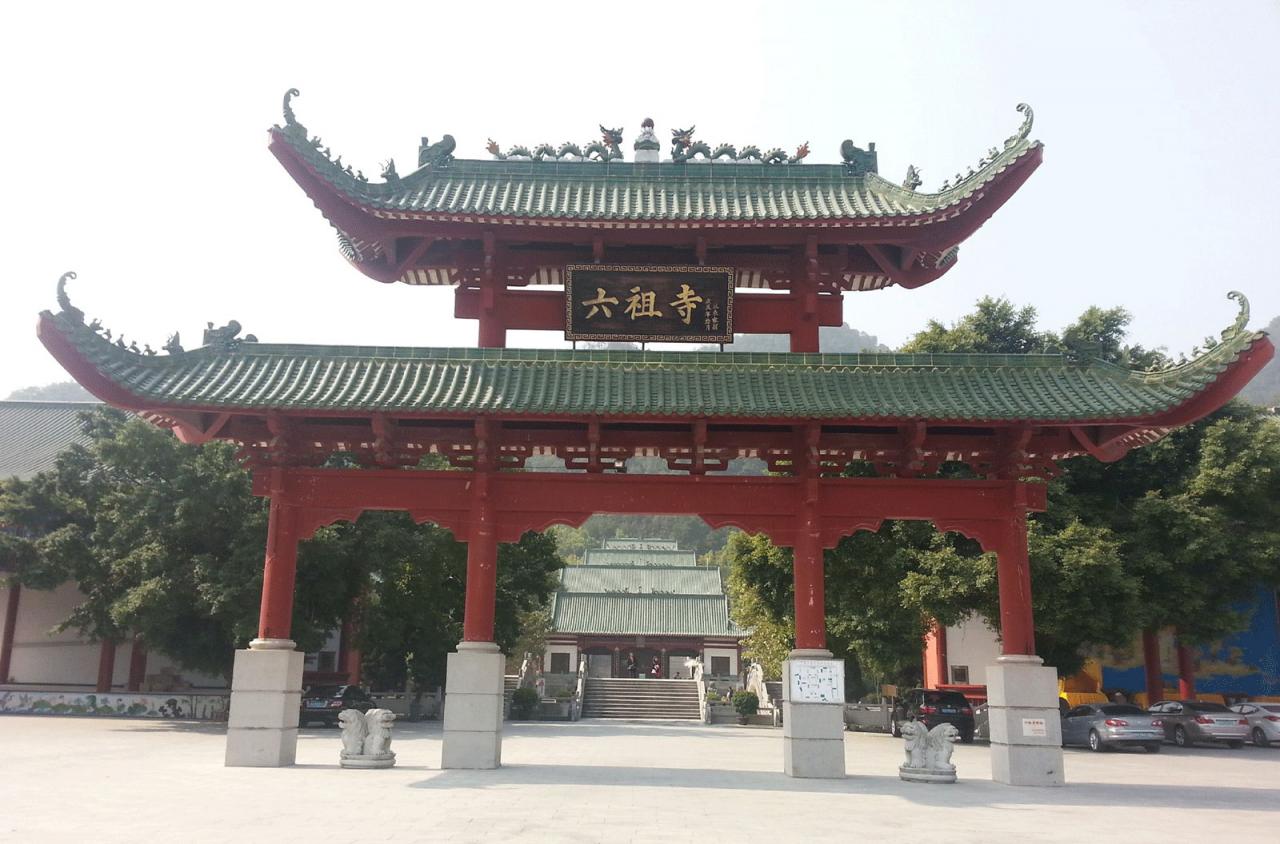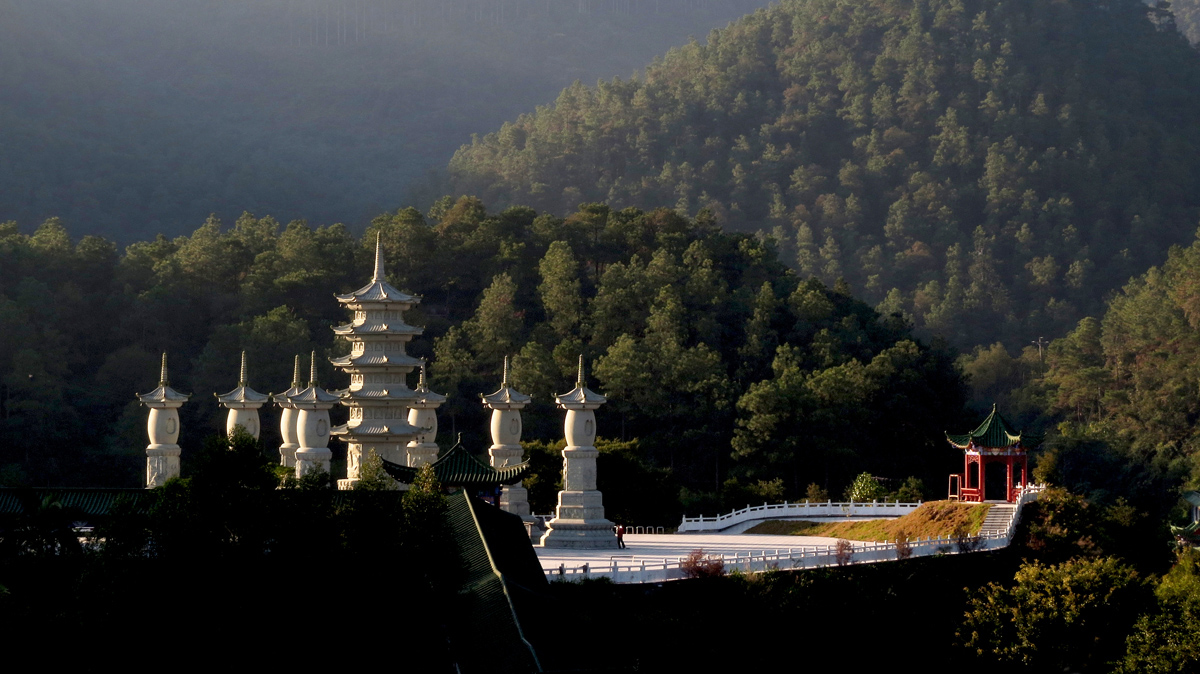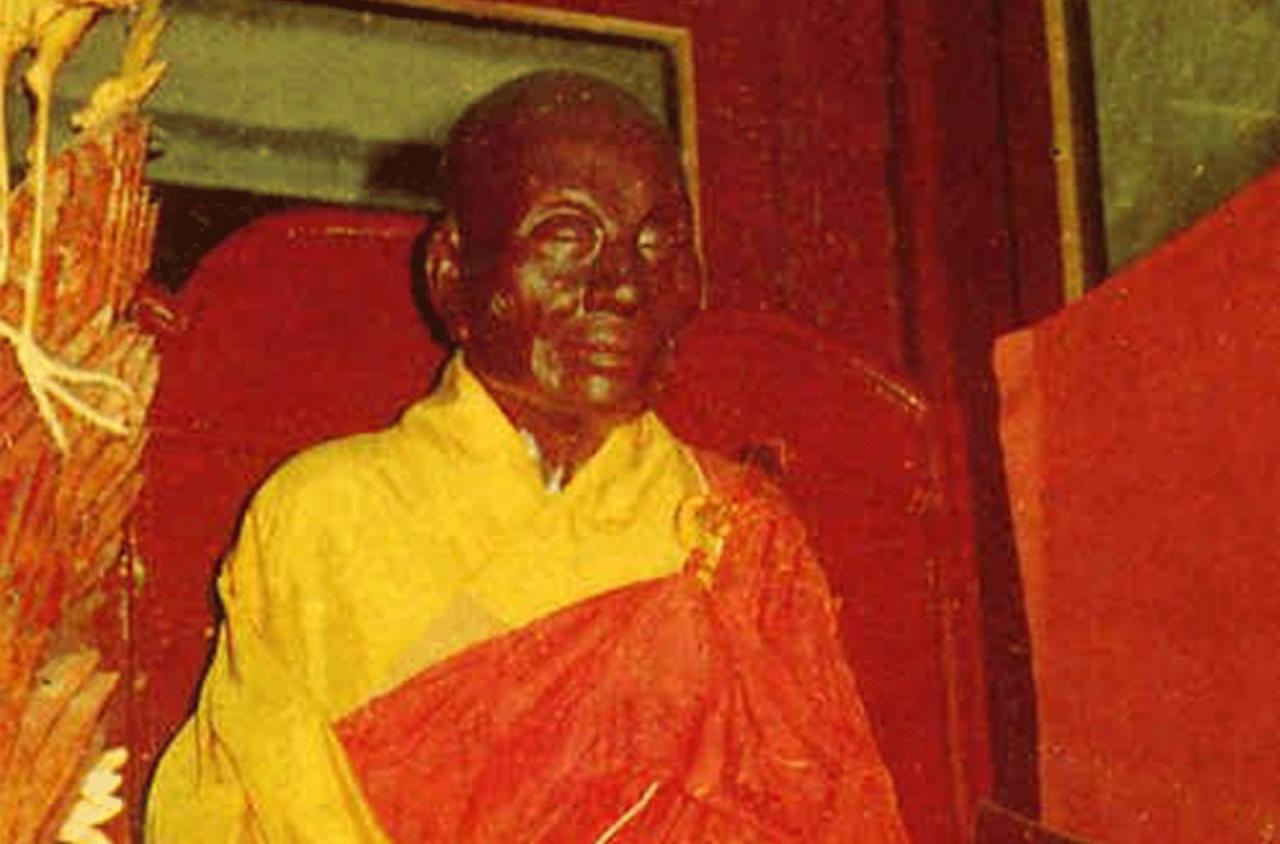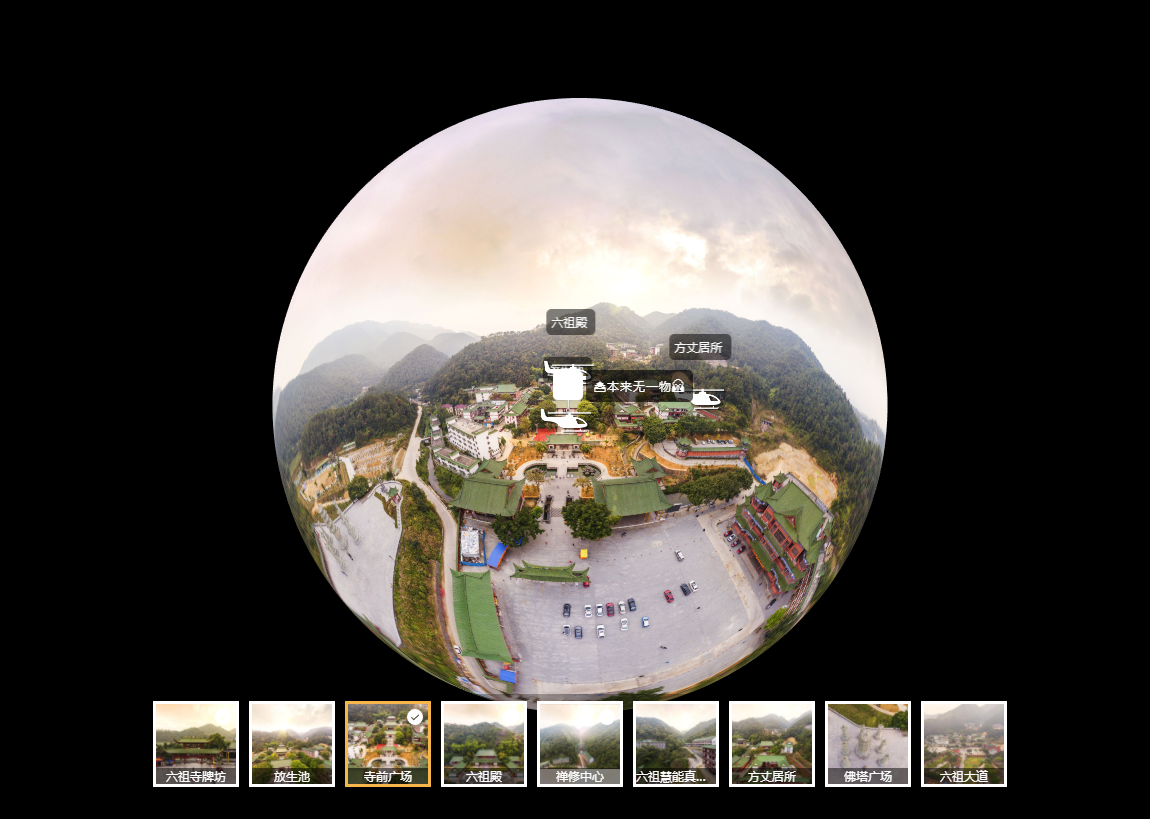六祖寺
Sixth Patriarch Temple
六祖寺

六祖寺位于广东省四会市贞山风景旅游区内。四会贞山是六祖惠能大师韬光养晦、隐居修行长达十五年的灵山胜地。原寺始建于唐代,属千年古刹。2000年11月重修告竣。六祖寺依山面水,左蟠青龙,右卧白虎,置身期间,瑞气呈祥,实乃佛门圣地。

在六祖大师的佛力感召下,大愿法师发宏大誓愿,决心绍隆祖师法脉,续佛真实慧命。在各级政府和领导的关怀和支持下,在四众弟子成就、十方檀越共举之下,现已形成规模较大的综合性寺院建筑群,成为岭南重要的宗教活动场所之一。主要建筑包括进山牌坊、广场、山门、天王殿、大雄宝殿、六祖殿、藏经阁、观音殿、罗汉殿、地藏殿、钟鼓楼 、方丈楼、退居方丈室、首座室、斋堂、客堂楼、弥陀安养村、僧寮房、 都监院、朝山会馆、讲法堂、禅堂、念佛堂(在建)。在左侧龙山和右 侧象山正建颂经亭和文殊塔,佛学院的建设也在紧张的进行中。如今, 六祖禅寺既是禅宗祖庭,也是世界佛教各宗各派修行、讲学、弘法和 安养的殊胜道场。远望宝刹,依山傍水、殿廓林立、白墙绿瓦,在蓝 天白云和青松桑田的环拥之中,犹如一片璀璨的翡翠。如虚云和尚舒怀:“尘外不相关、几阅桑田几沧海,胸中无所得、半是青松半白云。”

据《六祖法宝坛经》行由品记:禅宗六祖惠能大师(公元六三八至七一三年),俗姓卢氏,三岁丧父,家境艰贫,稍长以伐薪卖柴为业养母度日。二十四岁时,惠能辞母出家,往蕲州黄梅东山(今湖北黄梅市郊)参拜五祖弘忍大师。初为行者,随众劳役,踏碓舂米。惠能大师于东山禅寺五祖弘忍大师处得法并受衣钵后,五祖授记云:“努力向南,不宜速说,逢怀则止,遇会则藏。”

六祖大师乃于四会避于猎人队中,凡经一十五载。后大师于曹溪公开宣教三十七年,创立和宏扬了中国禅宗顿教法门,千百年来长盛不衰。然而,释尊正法眼藏、教外别传在东土之发扬光大,乃是大师在四会贞山隐居时奠基圆成的。 自释迦牟尼佛在灵山会上拈花示众、大迦叶尊者开颜微笑,禅宗的心印就传承下来了。椐经记载,世尊四十九年讲经说法三百余会,唯灵山会上不发一言,拈花示众,百万人天,莫知其意,独大迦叶尊者破颜微笑。世尊云:“吾有正法眼藏,涅盘妙心;实相无相,微妙法门;不立文字,教外别传;今附嘱摩诃迦叶。” 历代禅门祖师都是以心传心,大迦叶尊者传给二祖阿难陀、阿难陀传给三祖商那和修、商那和修传给四祖优婆毱多……到十二祖马鸣菩萨、十四祖龙树菩萨……传到达摩祖师时已是第二十八祖了。达摩大师到中国来,被称为东土初祖,后达摩祖师传二祖慧可、慧可传三祖僧璨、僧璨传四祖道信、道信传五祖弘忍、直到六祖惠能大师,称之为“一花开五叶”。 禅宗六祖惠能大师的应世,绝非偶然,是娑婆世界众生感应之必然,也是佛菩萨观机施教的机缘成熟所至。在禅宗史、乃至整个人类文明史中,六祖惠能大师的应世及坛经的重要意义超越了历代禅门祖师。 “何其岭南,有肉身菩萨出世。”六祖大师被称之为第二释迦,所以,六祖所说的妙法我们也尊称为经。历代祖师的开示,称之为经的惟有《六祖大师法宝坛经》。
教育办:0758-3308350
文化办:0758-3308303
普济会:0758- 3354727
法务流通:0758-3110486
信息中心:0758-3308722
视听中心:0758-3308667
发展办:0758-3108095
客 堂: 0758-3309613
地 址:广东省四会市贞山区六祖寺 邮 编:526200
Sixth Patriarch Temple
Sixth Patriarch Temple is one of the most well-known Buddhist temples in China and worldwide, because it is closely connected with the tradition of Chan Buddhism, which is rooted in China. It is located in the mountains of the Zhenshan region in the South Chinese city of Sihui, The temple is a magnet for many Buddhists from home and abroad.
When the Fifth Patriarch of Chan Buddhism Hong Ren (弘忍, 601-675) wanted to choose his dharma heir, during the Tang Dynasty more than 1300 years ago,he ordered all his disciples to compose verses and bring them to him. No disciples but Shen Xiu made a verse:
The body is a Bodhi tree,
The mind like a bright mirror stand,
Time and again brush it clean,
And let no dust alight.
Originally Bodhi has no tree,
The bright mirror has no stand,
Originally there is not a single thing,
Where can dust alight?
Hongren decided to make Huineng the Sixth Patriarch of the Chan Buddhism due to this Verse, which showed that Huineng has known his self-nature. Hongren explained to him The Diamond Sutra for him down to the line “One should produce a thought that is nowhere supported.”
After the Fifth Patriarch Hong Ren gave Hui Neng the Dharma transmission with the robe and the bowl transmitted from Bodhidharma(达摩,483-540. the first Patriarch of Chinese Chan Buddhism) , Hongren escorted Hui Neng to the Ferry of Jiujiang by himself, and told him, “Stop at Huai and hide at Hui.” Hui Neng took the robe and left for the South. When he arrived in Huaiji, Guangdong, he took asylum there for a while. Soon after, he was chased out by some villains again, so he had to continue his trip until he arrived in Sihui. He hid in a family of a hunter for 15 years. These experiences were reported in the famous “Sixth Patriarch’s Platform Sutra” (Liuzu Tanjing 六祖坛经), which has since become a classic of Chan Buddhism.
When Huineng lived in seclusion in Sihui, he obtained Enlightenment already. He practiced silently and founded the Chinese characteristic Buddhistic ideology to present the school of Sudden-Enlightenment. Because Hongren told Huineng, “Take living beings across by every method and spread the teaching for the sake of those who will live in their future. Do not let it be cut off.” Hui Neng knew that this was a heavy task and he always worked diligiently.
One day Hui Neng thought, “The time has come to spread the Dharma. I cannot stay in hiding forever.” Accordingly, he went to Faxing monastery (now called Guangxiao monastery, Guangzhou). Where Master Yin Zhong was teaching. He soon recognized Hui Neng was the Six Patriarch of Chan Buddhism and was very happy to ask for the teaching from Hui Neng. Soon after, he shaved Hui Neng’s head under the Bodhi tree and asked Vinaya Master Zhi Guang to give Hui Neng full ordination. Since then, Hui Neng began to explain the Maha Prajna Paramita Dharma under the Bodhi tree, and teach Chan Buddhism. Hui Neng returned to Baolin monastery in Caoxi not long after and explained the Dharma there for 37 years, his disciple Fahai wrote down all his teachings and edited it to the “Sixth Patriarch’s Platform Sutra” (Liuzu Tanjing 六祖坛经) which is well known in Chan -Buddhism and around the world. The Sudden-Enlightenment of Chan Buddhism proposed by Sixth Patriarch fostered the root and development of Buddhism in China.
In year of 713, Tang Xuanzong was in the second year as the emperor of Tang dynasty. The Sixth Patriarch went back to Guo’en monastery on 8th July in the lunar calendar and obtained Nirvana on 3rd August of the lunar calendar. His disciples escorted his true body back to Caoxi. His true body never decayed and was placed in a pagoda. Then a white light appeared within the pagoda, shot up into the sky, and did not fade for three days.
The master lived for 76 years in this world. The robe was transmitted to him when he was 24, and when he was 39, his hair was cut. For 37 years he spoke the Dharma to benefit living beings. 43 men inherited his Dharma and an uncountable number awoke to the way and overstepped the common lot.
The “Chapel of the Sixth Patriarch” (Liuzu’an 六祖庵) was built in the village where he hid to commemorate him. Because of the inconvenient transportation of the original Chapel, Sixth Patriarch Temple was rebuilt in the place that it is known by the world nowadays. The name of the old temple has been changed to” Tianxin Chan temple.”
The restructure of Sixth Patriarch Temple (Liuzu si 六祖寺)began from 1997, and in June 1999, Venerable Master Shi Dayuan(释大愿)was invited to take the responsibility of Abbot of the Sixth Patriarch Temple. As one of China’s youngest abbots, Master Dayuan took charge of the construction and revitalization of the Sixth Patriarch Temple. Comprehensive new buildings were built in the years 1997-2001. Other buildings, such as a retreat center and a terrace, where eight stone pagodas depict the life stations of the Sixth Patriarch, have been added in recent years.
Venerable master Shi Dayuan is the representative of several lineages of Chinese Chan Buddhism, he is in the 10th generation of the Weiyang School, and the 25th generation of the Caodong School. He is also the heir to the tantric lineage of Tang Dynasty Chinese Buddhism, which specializes in the practice of medicine-Buddha. He hopes Buddhism can benefit modern beings. He has made great efforts to preach the explanation of Buddhist Sutras in different places and is adept at connecting Chinese Buddhist Chan with all kinds of aspects in life. All these speeches have been published in more than 200 books and videos.
Sixth Patriarch Temple has been active at home and abroad in its transmission of Chan Buddhism school and retreat centers. It has systematic and complete approaches of different Chan Schools including Patriarch Chan, Tathagata Chan, and Esoteric Chan. Neiguan Chan (Contemplations-Meditation) and Acupuncture and Moxibustion Promoted Meditation (AMPM) are suitable for most people to practice.
Acupuncture and Moxibustion Promoted Meditation (AMPM针灸前行禅) combines the healing aspects of acupuncture and moxibustion with Buddhist meditation. Based on their theoretical foundations, practical experiences can be gained here that serve to overcome physical barriers and contribute to the realization of the true nature of the emptiness of all beings, as the Buddha once taught.
For the Contemplations-Meditation(内观禅), the temple regularly offers 10-day retreats. Per Retreat, up to 100 participants will be instructed in intensive practice. In these retreats, the temple combines the Southeast Asian meditation tradition with elements of Chan Buddhism handed down in China.
Today, there are more than 50 temples and centers with monks and nuns, as well as around many followers of the Sixth Patriarch Temple group worldwide.
Sixth Patriarch Temple is known for its dialogue with the various Buddhist traditions and maintains a worldwide exchange. Likewise, it is also engaged in dialogue with academic institutions and works with universities and colleges at home and abroad in various Buddhist and interdisciplinary areas, including Qinghua University, Wuhan University, Chinese University of Hong Kong and the University of British Columbia. It also founded the Tianzhu Buddhist network, which including famous universities all over world.
Sixth Patriarch Temple, through its own “Tianzhu Culture Charitable Fund”, offers various programs scholarships to young people around the world who want to study the Chinese language and Chinese Buddhism in China. The charitable fund has donated to many schools, beadhouses, and orphanages with the help of many kind people.
In the summer of 2017, Abbot Dayuan inaugurated the “Liuzu Temple Germany” near Göttingen. The goal is to introduce Chinese Buddhism to Europe, to which other centers in other countries are to be connected. Till now there are monasteries belong to Sixth Patriarch Temple scattered in Asia, Europe and North America. They are all opened to public to practice Meditation, learn Chinese Buddhism, to help people raise the quality of life.
Sixth Patriarch Temple strive to give the word peaceful, meaningful, pure energy by various form of activities all over the world.
Interested parties can contact:
liuzu.huineng.temple@gmail.com
Sixth Patriarch Temple wants to thank for kind-hearted people who supported and will continue to support us.
六祖寺鸟瞰图
你来与不来,
六祖寺都在这里……
六祖寺都在这里……
未经允许不得转载: » 遇会则藏——四会六祖寺









